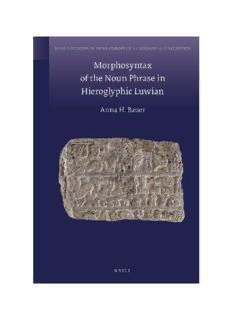
Morphosyntax of the Noun Phrase in Hieroglyphic Luwian PDF
Preview Morphosyntax of the Noun Phrase in Hieroglyphic Luwian
Morphosyntax of the Noun Phrase in Hieroglyphic Luwian Brill’s Studies in Indo-European Languages & Linguistics Series Editors Craig Melchert (University of California at Los Angeles) Olav Hackstein (Ludwig-Maximilians-Universität Munich) Editorial Board José-Luis García-Ramón (University of Cologne) Andrew Garrett (University of California at Berkeley) Stephanie Jamison (University of California at Los Angeles) Joshua T. Katz (Princeton University) Alexander Lubotsky (Leiden University) Alan J. Nussbaum (Cornell University) Georges-Jean Pinault (École Pratique des Hautes Études, Paris) Jeremy Rau (Harvard University) Elisabeth Rieken (Philipps-Universität Marburg) Stefan Schumacher (Vienna University) VOLUME 12 The titles published in this series are listed at brill.com/bsiel Morphosyntax of the Noun Phrase in Hieroglyphic Luwian Βy Anna H. Bauer LEIDEN | BOSTON INAUGURAL-DISSERTATION zur Erlangung des Grades einer Doktorin der Philosophie (Dr. phil.) dem Fachbereich Fremdsprachliche Philologien der Philipps-Universität Marburg vorgelegt von Anna Henriette Bauer aus Kassel M.A. Gutachter: Prof. Dr. E. Rieken; Prof. Dr. H.C. Melchert eingereicht am 8. Februar 2013 Tag der mündlichen Prüfung: 8. Mai 2013 Göttingen 2013 Hochschulkennziffer: 1180 Cover illustration: Hieroglyphic Luwian inscription on stone, JISR EL HADID fragment 1, 9th or 8th century BC. Picture courtesy of the Oriental Institute of the University of Chicago. Library of Congress Cataloging-in-Publication Data Bauer, Anna H. Morphosyntax of the noun phrase in hieroglyphic Luwian / by Anna H. Bauer. p. cm. — (Brill’s studies in Indo-European languages & linguistics; Volume 12) Includes bibliographical references and index. ISBN 978-90-04-26002-3 (hardback : alk. paper) — ISBN 978-90-04-26003-0 (e-book) 1. Luwian language—Grammar. 2. Inscriptions, Luwian. 3. Inscriptions, Hieroglyphic. 4. Anatolian languages— Morphology. 5. Grammar, Comparative and general—Noun phrase. 6. Grammar, Comparative and general—Morphosyntax. I. Title. P949.B38 2014 491’.998—dc23 2014020413 This publication has been typeset in the multilingual ‘Brill’ typeface. With over 5,100 characters covering Latin, ipa, Greek, and Cyrillic, this typeface is especially suitable for use in the humanities. For more information, please see brill.com/brill-typeface. issn 1875-6328 isbn 978 90 04 26002 3 (hardback) isbn 978 90 04 26003 0 (e-book) Copyright 2014 by Koninklijke Brill nv, Leiden, The Netherlands. Koninklijke Brill nv incorporates the imprints Brill, Brill Nijhoff, Global Oriental and Hotei Publishing. All rights reserved. No part of this publication may be reproduced, translated, stored in a retrieval system, or transmitted in any form or by any means, electronic, mechanical, photocopying, recording or otherwise, without prior written permission from the publisher. Authorization to photocopy items for internal or personal use is granted by Koninklijke Brill nv provided that the appropriate fees are paid directly to The Copyright Clearance Center, 222 Rosewood Drive, Suite 910, Danvers, ma 01923, usa. Fees are subject to change. This book is printed on acid-free paper. To G.LL.P., who chose to stay. ∵ Contents Preface xi Abbreviations xii 1 Introduction 1 1.1 Aims and Scope 1 1.2 History 6 1.2.1 Linguistic History 9 1.3 The Corpus 13 1.3.1 Texts 13 1.3.2 Origin of the Texts 18 1.3.3 Methodology 18 1.4 Writing Systems 21 1.4.1 Orthographic Conventions 25 1.5 Grammatical Overview 26 1.5.1 Nominal Inflection 26 1.5.2 Pronominal Inflection and Clitics 31 1.5.3 Agreement 34 1.5.4 Basic Word Order 35 1.6 The Data 37 2 Determination 40 2.1 Definiteness 40 2.2 Demonstratives: za- and apa- 42 2.3 Possessives as Determiners? 52 2.4 Word Order of Determiners 55 2.5 Summary 61 3 Quantification 63 3.1 Non-numerical Quantifiers 63 3.2 Numerals 71 3.2.1 Unexpected Plurals? 83 3.2.2 Collectives? 85 3.2.3 Type of System 88 3.3 Word Order of Quantifiers 100 3.3.1 Non-numerical Quantifiers 100 3.3.2 Numerals 106 3.4 Summary 114 viii contents 4 Modification 117 4.1 Non-possessive Modifiers 119 4.1.1 Adjectives and Participles 119 4.1.2 Simple Modification 121 4.1.3 Stacked Modifiers 126 4.1.4 Complex Participial Modifiers 127 4.1.5 Summary 132 4.2 Possession 132 4.2.1 Unmarked and External Possession 134 4.2.1.1 Unmarked Possession 135 4.2.1.2 External Possession 138 4.2.2 Genitives 142 4.2.3 Genitival Adjectives 147 4.2.3.1 The Suffixes -izza- and -wann(i)- 151 4.2.3.2 The Suffixes -assa/i-, -iya/i- and -alla/i- 154 4.2.4 Genitives and Genitival Adjectives 165 4.2.4.1 Distribution of Genitives vs. Genitival Adjectives 169 4.2.4.2 Unexpected Genitives 176 4.2.5 Pronominal Possessors 186 4.2.5.1 First and Second Person Possessives 188 4.2.5.2 Third Person Possessives 205 4.2.6 Multiple Possessors and Possessa 211 4.2.7 Free-Standing Possessives 217 4.2.7.1 Linking Verb Sentences 217 4.2.7.2 Free-Standing Possessives 221 4.3 Word Order of Modifiers 225 4.3.1 Non-Possessive Modifiers 229 4.3.1.1 Order Relative to the Head 229 4.3.1.2 Order among Stacked Modifiers 235 4.3.2 Possessives 240 4.3.2.1 Postnominal Possession 240 4.3.2.2 Circumnominal Possession 267 4.4 Summary 270 5 Apposition 274 5.1 Titles and Relational Terms 281 5.2 Simple and Stacked Appositions 285 5.3 Extended Appositions 290 contents ix 5.4 Word Order of Appositions 297 5.4.1 A Special Case: DOMINUS ‘Lord’ 302 5.5 Summary 306 6 Conclusion 308 Bibliography 317 Index 334
Description: